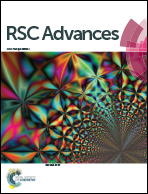Interface enriched highly interlaced layered MoS2/NiS2 nanocomposites for the photocatalytic degradation of rhodamine B dye†
Abstract
In the past few decades, air and water pollution by organic dyes has become a serious concern due to their high toxicity. Removal of these organic dyes from polluted water bodies is a serious environmental concern and the development of new advanced photocatalytic materials for decomposing organic dyes can be a good solution. In this work, layered molybdenum disulfide/nickel disulfide (MoS2/NiS2) nanocomposites with various NiS2 content was synthesized by a one-step hydrothermal method using citric acid as a reducing agent. The X-ray diffraction pattern shows the hexagonal and cubical crystal structure of MoS2 and NiS2, respectively. Morphological analysis confirms the formation of MoS2/NiS2 nanosheets. The elemental composition of the samples was carried out by XPS, which shows a significant interaction between NiS2 and MoS2. The photocatalytic performance of MoS2/NiS2 nanocomposites was studied by the degradation of rhodamine B (RhB). Ni-4 sample shows higher photocatalytic activity with a maximum degradation of 90.61% under visible light irradiation for 32 min.



 Please wait while we load your content...
Please wait while we load your content...